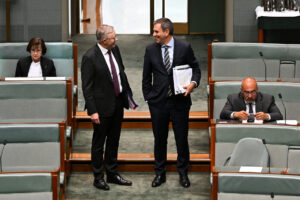The greatest trick Tony Abbott ever pulled
In the latest episode of podcast, The Lucky Country, Richard Denniss and Ben Oquist break down Tony Abbott’s attack on renewables
“This renewable energy target is doing massive damage to our country and that’s why there should be no subsidies for any further renewables now.”
— Former Prime Minister Tony Abbott
This is Tony Abbott doing what he does best: making the complex seem simple and the unconscionable seem inevitable. Having ‘stopped the boats,’ it seems the former Prime Minister’s latest goal is to ‘stop the facts.’
But here’s the simple truth: the Renewable Energy Target is not a subsidy, just like requiring cars to have seat belts isn’t a subsidy for seat belts.
But here’s the simple truth: the renewable energy target is not a subsidy, just like requiring cars to have seat belts isn’t a subsidy for seat belts.
The subsidy that we should be talking about in Australia at the moment are the subsidies for coal, but thanks to Tony Abbott they’re the only ones we’re not talking about.
This is part of Tony Abbott’s genius.
The Coalition and the Minerals Council of Australia are working tirelessly to suggest the the poor old coal industry is a victim of big bad renewable energy. It’s an old trick but unless it’s confronted head on, it may well work.
The RET was actually implemented by that well-known lefty John Howard, and the reason that the RET has been growing over time is that consumers and voters have made clear that they want it to grow.
Just as most people are willing to demand and pay for clean water, clean food and clean streets, poll after poll shows the majority of Australians are keen to get clean energy as well.
Just as most people are willing to demand and pay for clean water, clean food and clean streets, poll after poll shows the majority of Australians are keen to get clean energy as well.
We can do this the easy way or we can do it the hard way
Is it true that Australia has ‘too much’ renewable energy, and that it’s causing us problems?
Australia actually only has about 9.5% of wind and solar capacity, but we’re a long way off where we need to be and a long way off where we’re about to get to be.
The question is can we do it in the most cost effective way? And if the Government can provide a signal or structure, we can do it the easy way; or, they can leave a mess and we can do it the hard way.
We know where we’re going to end up, we’re just haggling over how much it costs and how quickly we get there.
“There’s this myth about ‘base load power’.
But Australia effectively has a peak load problem not a base load problem — those spikes in electricity demand in particularly in Summer.”
There’s this myth about ‘base load power’.
But Australia effectively has a peak load problem not a base load problem — those spikes in electricity demand in particularly in Summer.
We’ve got an ageing coal fire power sector dominated by coal, and they’re old and they’re dying and they’re dirty and they’re polluting.
And as ageing coal fire power stations retire, they are going to be replaced with the most cost effective solution and that’s the thing about renewables and that’s the big shift that’s happened: renewables are now driving down prices.
And more renewables in the future will increase that downward pressure.
The combination of renewables and storage is actually going to help Australia meet it’s energy needs in a much better way, unlike old coal fire power stations which, like Liddell, fail in the heat.
When Liddell was most needed, when we almost had blackouts in NSW in February, Liddell wasn’t even operating at full capacity — it was at less than half capacity — because it’s old, it’s dirty, and most crucially: it can’t stand the heat.
Old coal fired power stations aren’t very ‘agile’, they can’t follow the demand peaks and they’re providing the same amount of power all day long whether we need it or not, they’re just not designed for modern energy use.
“Old coal fired power stations aren’t very ‘agile’, they’re just not designed for modern energy use.”
Ben Oquist says he’s quite fond of quoting Prime Minister Malcolm Turnbull, who says “you must be guided by economics and engineering.”
So the Australia Institute had a look at government economics, government modelling, government commissioned modelling, and independent modelling, to look at how as a country we could best meet Tony Abbott’s own (read: low-ball) emissions reduction targets and what that modelling shows is you would need renewable energy generation of between 66–75% by 2030.
“And the good news is renewables are now driving down electricity prices, and I think politics hasn’t caught up with the fact that that’s the big shift that’s happened,” concluded Ben Oquist
— —
Meeting our Paris Commitment is the first major report to be published by
The Australia Institute’s Climate & Energy Program.
Between the Lines Newsletter
The biggest stories and the best analysis from the team at the Australia Institute, delivered to your inbox every fortnight.
You might also like
RN Breakfast: Redesigning the Stage 3 Tax Cuts
Richard Denniss joins ABC RN Breakfast with Patricia Karvelas to discuss redesigning the Stage 3 tax cuts.
The Issues That Will Shape 2024 | Between the Lines
The Wrap with Richard Denniss Happy New Year! While it’s only mid-January, 2024 is already off to a big start. US bookmakers have Donald Trump as favourite for the next presidency, Australia is getting drawn into US foreign policy in the Middle East, domestic debate about the $320 billion Stage 3 tax cuts is heating
Extract: Heat – Life and Death on a Scorched Planet by Jeff Goodell
When heat comes, it’s invisible.

